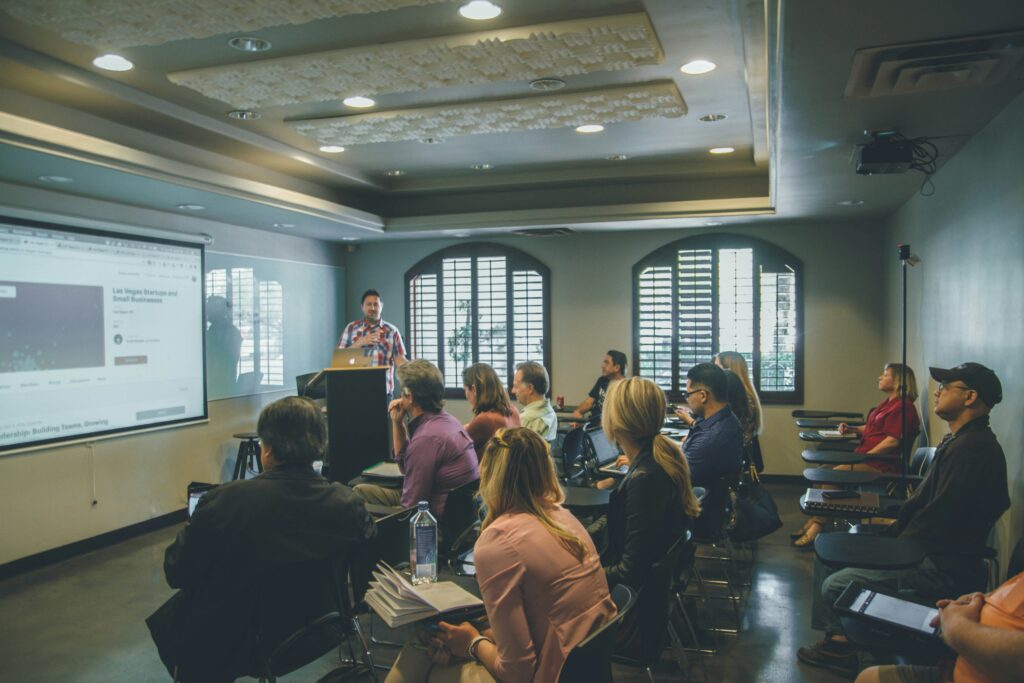Overview
Introduction

Presentations and lectures are effective methods for transferring information. Information is part of nearly every college class, so you expect to see some presentations and lectures in most classes. However, presentations and lectures are not effective methods for teaching students thinking skills, for helping them learn to solve problems, develop skills, or change attitudes or perspectives. The first key in developing effective presentations and lectures is to use them only for the right purpose.
Effective Presentations
To deliver an effective presentation it is helpful to know a little bit about how we pay attention to, process, and remember information. Research about attention shows that our attention can be very focused, but it’s also limited. We can only pay attention to select things at a time and in fact multi-tasking is a myth. If we want to convey information, we first need to gain our students attention.
We also know that humans process information based on context, meaning and prior knowledge. If students have misconceptions or a lack of context, it’s more difficult for them to process new information. The more we can help students find meaning and provide them with examples and analogies they can relate to, the easier it will be for them to learn from our presentations.
The ultimate goal for our presentations is for students to remember the information. Yet humans have a limited capacity for the amount of information we can remember. A seminal study on memory showed that we can remember seven, plus or minus two, new pieces of information before we reach capacity. So cramming more and more information into a presentation, or speaking faster if you run out of time, are not methods that would result in students remembering the information.
Tips for Effective Presentations
So, how do we develop effective presentations?
- recognize that presentations are only effective for transmitting information and use them sparingly for this purpose
- gain and keep your students’ attention – don’t compete with distractions and help them see where and how to focus their attention. You might visit this page about mobile devices in the classroom
- help students discover the overall structure in the information being presented by chunking information and providing advanced organizers (outlines, visual aids, graphic organizers)
- give students context for new information and help them make personal meaning of new information
- find out the prior knowledge of your students and adjust the presentation accordingly
- use relevant visuals and images to help them process and remember information
- keep students actively involved, don’t give them the opportunity to get bored. Consider using clickers or group work for larger classes
Additional Resources:
Accessibility Considerations
When designing a presentation or lecture, it is important to consider accessibility–remember that you have a diverse range of students in your course, and they may not all have the same range of abilities or be able to access materials in the same way.
- Create accessible PowerPoints
- Provide captions or transcripts for any video content
- Provide slides or presentation notes ahead of time, and give the option for printed materials
- Include an overview slide that outlines the main points of your lecture
- Use accessible fonts, color contrast ratios, and alt-text when necessary
- If you have a microphone in your class, be sure to use it!
For more accessibility tips, check out these resources:
Ed Tech Tools for Presentations
Another helpful tip for designing effective presentations and lectures is to utilize educational technology (ed tech) tools that promote engagement and active learning. Some popular tools for encouraging student engagement during a lecture or presentation include:
- TopHat: provides the ability for instructors to incorporate interactive content, create interactive slides, graded questions, videos, discussions, polls, and more.
- Padlet: a digital bulletin board that is collaborative and interactive where you can create a single or multiple “walls” for various posts.
- Mentimeter: a presentation tool that uses quizzes, polls and word clouds engage students for in-person and virtual classrooms.
- Nearpod: an online tool that allows you to add interactive elements to your PowerPoint slides and pre-recorded lecture videos.
- Kahoot: a digital game-based student response system that allows teachers and learners to interact through competitive knowledge games using existing infrastructure, like phones or laptops.
This is just the tip of the iceberg when it comes to incorporating outside tools into your lectures or presentations. Should you wish to incorporate any of these tools, it’s crucial to be mindful of privacy concerns, such as FERPA, potential accessibility issues, and to ensure that the tools you select align with the learning outcomes or goals of your presentation or lecture.


